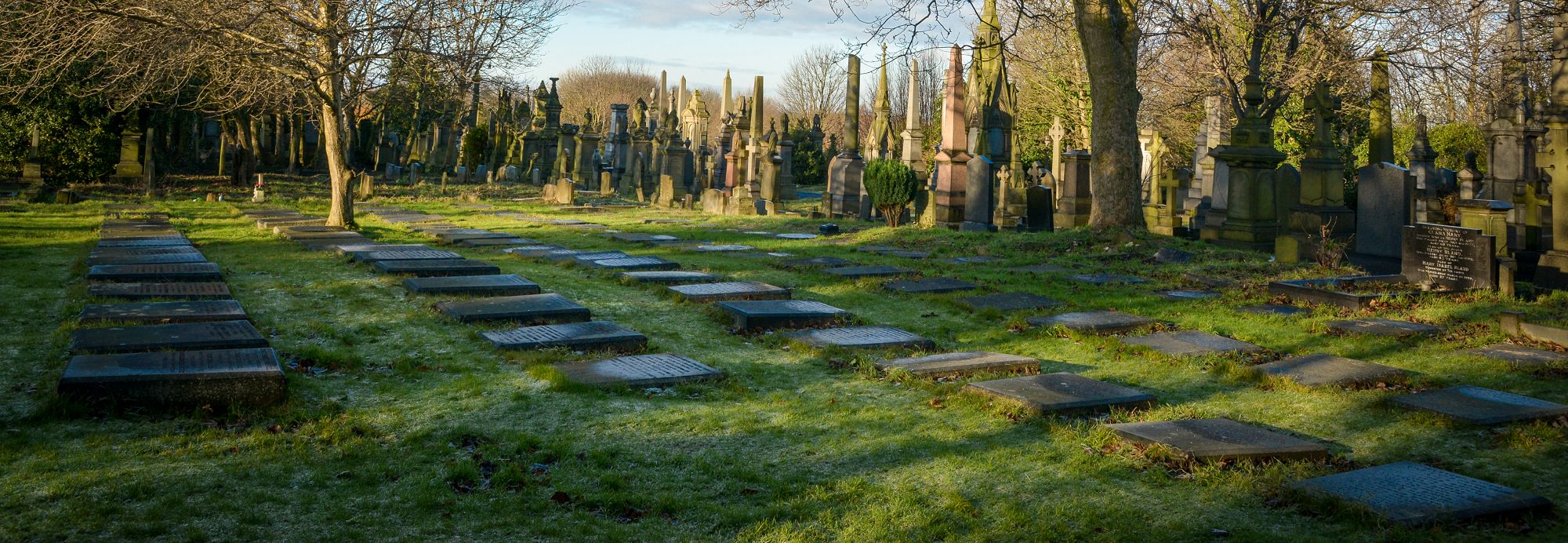Samuel Smith
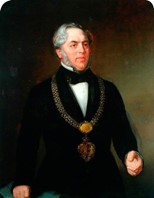
Alderman & 5th Mayor of Bradford (1851-54)
This Image courtesy of Bradford Museums and Galleries
Samuel Smith was born on 23 August 1804 and baptised on 23 September 1804 at Christ Church and St. Peter’s, Sowerby Bridge, Yorkshire to Joseph, a Dyer, resident at Skircoat, Halifax and his wife Elizabeth.
When Samuel was 28 he married Mary Aked 22 of Midgley, Halifax on 20 November 1832 in Halifax. The daughter of James Aked and his wife Elisabeth, she was born on 4 May 1810 and baptised on 20 June 1810 in Halifax.
In 1841 at Kershaw House, Halifax, Samuel was living with the Aked family, he a Dyer age 35 with his wife Mary nèe Aked now 30 and their 4-year-old son Samuel Milne Aked Smith b. 15 December 1836 and baptised on 29 March 1837 in Halifax. At this time, their daughter Elizabeth Aked Smith, b. 27 January 1834 and baptised on 16 march 1834 at the Sion Chapel in Wade Street (an Independent Chapel), Halifax, was a Pupil at Square Road where it meets Horton Street, Halifax, with the Garlick family where Sarah Garlick was a Schoolmistress.
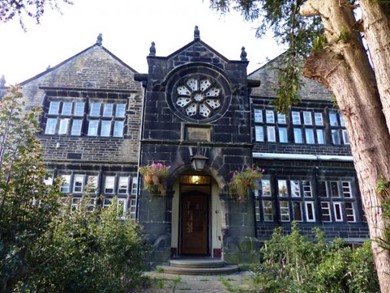
Kershaw House, Midgley, Halifax. Grade II listed. Built 1650.Samuel was elected Alderman in 1847. Also, in that year, as he was a great lover of music and the author of several excellent compositions, he met with the master Mendelssohn in Birmingham.
In 1851 they were living at Field House, Field Head Cottages, Little Horton, Bradford, he (46) an Alderman & Magistrate of Bradford, Dyer employing 190 men & 50 boys, with his wife Mary and their two sons Samuel M A Smith (14) and Edward James Smith (9) b. 17 December 1841 in Bradford. They had 2 female servants from Thornhill and Halifax. Samuel was head in his lifetime of his extensive firm Horton Dyeworks at Preston Street: “Samuel Smith & Sons Co., Ltd.”. Meanwhile, their daughter Elizabeth was a 17-year-old Housemaid to William Wainhouse (69) an Annuitant at Washer Lane Top, Halifax, alongside a Cook.
One of Bradford’s most active public citizens, Samuel served three terms of office as Mayor of Bradford from 1851 to 1854 and at the end of his term a superb entertainment was given at St. George’s Hall where about 180 gentlemen attended. You should see the menu!!! While in office he promoted the purchase of the Waterworks Company by the Corporation.
In May 1855 at the Bradford Chamber of Commerce meeting, Samuel was President and stated that following an official invitation to the opening of the Paris Exhibition, he had attended where Bradford goods were displayed which included damasks and barèges, a lightweight, sheer gauze-like fabric made from Worsted which is usually mixed with silk or cotton, dyed by his firm. He was also a juror for worsted and mixed fabrics.
On Christmas Day 1858 at Eccleshill United Methodist Free Church, Samuel attended the annual tea meeting of over 500. On the wall were a number of mottoes, one of which bore the words ‘Samuel Smith for ever’ in appreciation of his indefatigable efforts in the Sunday School. At close he gave a humorous speech in thanks to the ladies.
In January 1860 about 120 ladies and gentlemen took part in a soiree at St. George’s Hall including the annual meeting of the Bradford Festival Choir Society under the Presidency of Samuel Smith Esq., a very successful society established in 1821, then with 260 members. The Society was established mainly through Samuel’s influence, his powers in music and devotion to its cultivation and its President up to his death.
Samuel Smith was also Chairman of the St. George’s Hall Company.
St. George’s Hall is a Grade II listed building, one of Bradford’s oldest dating from 1851 when the foundation stone was laid. It was erected on land paid for by Sir Titus Salt. The architects were Lockwood & Mawson and the cost £35000. It opened in 1853, illuminated by 1700 gas chandeliers and catered for everyone from the rich to the poor. Royals visited and it established excellent links with trade. In 1896 it became a cinema (one of the very early ones) until it closed in 1949. After a £10M refurbishment, funded by Bradford Council and the National Lottery Heritage Fund, it reopened in 1963 as a Concert Hall for e.g., Rock & Pop concerts.
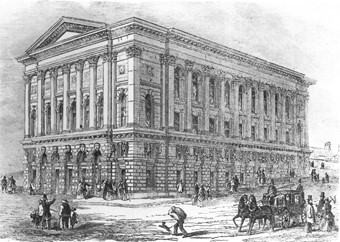
In Jul-Sep 1860 in Bradford, Samuel & Mary’s eldest daughter Elizabeth Aked Smith married John Joseph Coleby and a daughter Mary was born in Jan-Mar 1861 in Kensington, London.
In 1861 Samuel & Mary were still at Field House, Samuel a Magistrate of the Borough of Bradford and a Master Dyer employing 275 men, 60 boys and 6 women, with his wife and sons Samuel, now a Master Pattern Dyer, Edward, a Lawyers Articled Clerk, plus another son Charles Telford Smith b. Oct-Dec 1844 in Bradford, a Pupil to a Stuff Manufacturer and now another daughter Isabella Harriot Martineau Smith born Apr-Jun 1851 in Bradford, a Scholar. They had 3 female servants: Cook, and 2 Housemaids.
Meanwhile, still in 1861, at 24 Durham Terrace, Paddington, Middlesex/Kensington, London was residing Samuel & Mary’s eldest daughter Elizabeth with her husband John J Coleby, a Brick Merchant, b. 1828 in Wandsworth, Surrey, with their 2-month-old daughter Mary Coleby b. in Paddington, Middlesex. They had 3 female servants.
In September 1863 Samuel was up for election to Alderman with another candidate. It was a choice between equals. Samuel lost the vote by 11 to 26.
On 26 April 1871 Samuel attended a meeting of the Council to propose partitioning Parliament in favour of the Bradford & Thornton Railway Bill to construct the line to connect with the lines north and south of Bradford. This had originally been proposed in 1864/65. He supported it as it would benefit his firm. The motion was carried.
In politics a Whig – he took no active part in his later life.
In 1871 they had moved to Calverley House, Calverley in the Parish of St. Wilfred’s. Samuel was 66 and a Stuff Dyer & Finisher employing 450 men, women & boys plus a Gardener and Coachman; with him was just his wife Mary and daughter Isabella now 20. They had 2 servants: Cook & Housemaid. Their daughter Elizabeth with her husband John J Coleby, a Brick Agent, were at Parkhurst House, Brentford, West London, with their daughter Mary, a Scholar.
Samuel Smith, late of Field House, Bradford, passed away on 3 July 1873 at Cliffe Hall, Warley, Halifax. For two or three years his health was not good; while employing himself in the hay field he caught a cold leading to congestion of the lungs – and death. There were 7 carriages in the funeral procession: 1st: Mr. S Milne Milne, Mr Bertram Milne, Mr E J Smith & Mr C Telford Smith (two of his sons); 2nd: Mr Titus Salt’s; 3rd. The two Reverends from Halifax & Bradford; the others followed of e.g., Sir Jacob Behrens. A contingent of the Bradford Festival Choral Society (including the President) were waiting in Horton Lane Chapel. The funeral procession left Field House for the Chapel via Thornton Road, passing large crowds; at the Chapel there were workmen from his firm. The coffin was of polished oak, brass mounted and the inscription “Samuel Smith died 3 July 1873 aged 68 years”. There it was revealed his religious faith and strong ties with his family; in society a broad-minded man; in the church a willing and effective worker; in retirement he mustered the village choir and always at rehearsals. The procession re-formed with police at the head, then his workmen, Festival Choral Society members, Magistrates & Aldermen, friends then the carriages. The hearse was guarded by men from Horton Dyeworks. It set off along Tyrrel Street, Bridge Street, to St. George’s Hall, Hall Ings, Leeds Road and Otley Road. At Undercliffe Cemetery several thousand people assembled. The freehold brick vault was in the Non-Conformist area adjacent to those of Mr Robert Milligan and Alderman Ramsden. Later his portrait in oil by Sir D Gordon was placed in St. George’s Hall Saloon in honour of his endeavours.
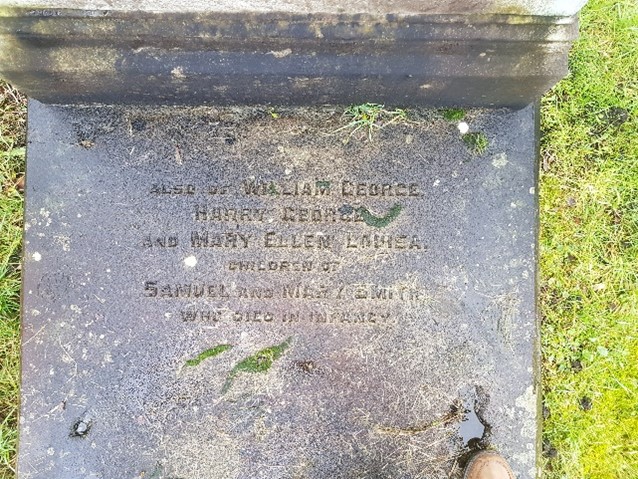
This picture shows three infants buried with Samuel and Mary: William George Smith b. 28 June 1843 and baptised 18 August 1843 in St Peters, Bradford Cathedral, Harry George Smith b. Apr-Jun 1843 in Bradford & Mary Ellen Louisa Smith b. 26 October 1843 and baptised in St Peters Church, Bradford on the 25 December 1843. So thought to be a reburial as the Cemetery opened in March 1854.
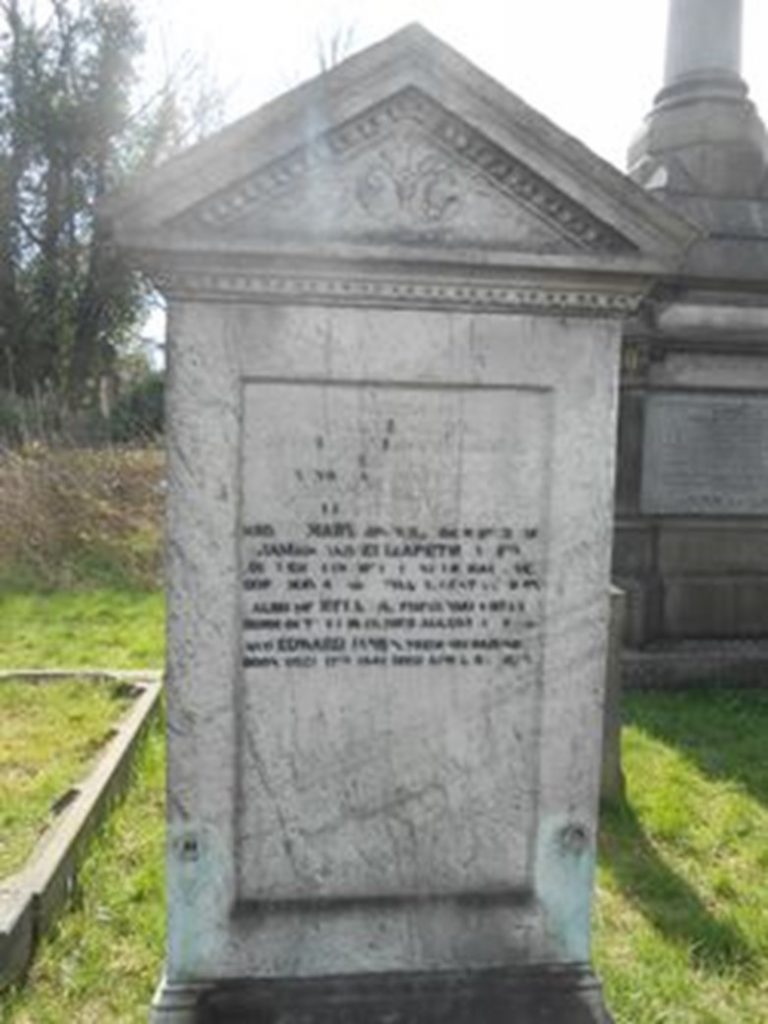
Probate on 14 October 1873 was granted to Samuel M Smith of Calverley, Edward James Smith, Charles Telford Smith of Cliff Hill (his 3 sons) and Robert Harrington Smith.
In 1881 we find Samuel’s wife Mary Smith, a widow, still at Cliff Hill House, Warley, Halifax, now age 70 with her grand-daughter Mary Coleby (20) b. Jan-Mar 1861 in Kensington, London, and two Domestic Servants, a Nurse and Housemaid. Samuel’s wife had continued to live there until a few months before she died when she moved back to Bradford. She died 24 August 1883 age 73 at Field House, Horton, Bradford and buried in Undercliffe Cemetery on 30 August 1883 with her husband, some children and the infants.
So, what happened to the children?
Samuel M Smith Esq. of Calverley House, Calverley, Leeds married Anne Eliza Clark of Addlestone, Surrey on the 30th April 1867 at St Luke the Parish Church, Homerton Terrace, Hackney, London. She was born Jul-Sep 1846 in Hackney, London, the daughter of Henry Clark of London and Anne nèe Milne who was the daughter of Thomas Milne of Cliffe Hill, Warley near Halifax. Anne Eliza Clark became the heiress to the Cliff Hill estate.
In 1871 they were living at Field House, Horton, Bradford, he a Dyer of 34 with his wife Anne (24), daughter Louisa Milne Smith b. Jan-Mar 1868, and sons Bertram Henry Milne Smith b. Apr-Jun 1869 & Preston Milne Smith b. Feb-Mar 1871, all in Bradford. They had 4 female General Domestic Servants.
They had another daughter, Gertrude Milne Smith b. 20 Apr 1874 and baptised 9 July 1874 in St Wilfred’s Church, Calverley.
In July 1877, Samuel M Smith and Charles Telford Smith of Bradford were making improvements in finishing moreens [A fabric of wool, or very often of cotton and wool, similar to tammy, commonly watered, but sometimes plain. It is used for petticoats, bathing-dresses, etc., and the heavier qualities for curtains and upholstery] and carded fabrics.
On the death of Samuel Milne of Gordon Bank, the Cliffe Hill estate passed to Mrs. and Mr. S. M. Smith, he taking the surname of Milne, and was admitted to Cliff Hill on 1st July 1878. His father Mr. Samuel Smith of Bradford came to reside here soon after the death of Mrs. Aked.
In 1881 at Calverley House, Calverley, Bradford we find Samuel [Samuel Milne Aked Milne] now 44 and a Land & House Owner, his wife Ann E Milne 34 with Louisa M Milne 13, now Eustace M Milne b. 1873 in Calverley and Gertrude M Milne b. 1875 in Calverley, all Scholars taught at home. They had 5 servants: Governess, Cook, Nurse, Waiting Maid & Housemaid.
Bertram and Preston were elsewhere:
Bertram was at 1 Oakfield House & School (now Oakfield Primary Academy), Rugby, Warwickshire. He was an 11-year-old Scholar/pupil among 28 students from 9 to 15 years old under Schoolmaster Reginald Lea, who ran the boarding school with a Matron and Assistant Matron, Cook, Parlour Maid, 2 Housemaids and a Kitchen Maid.
Preston was nowhere to be found, not even under the surname Smith, but presumably at school somewhere as was his brother Bertram.
In 1891 Samuel and Anne were still at Calverley House, he living on his own means, with 4 servants: Cook, Parlour Maid, Housemaid & Kitchen Maid. All the children had flown the nest.
Louisa M Milne and Bertram H M Milne could not be found in Britain nor any evidence of emigrating.
Preston M Milne and his brother Eustace M Milne were at 2 Hawthorn Terrace, Gildersome, Wortley, Leeds, both Engine & Machine Makers (supposedly the sons of George & Lydia Kelsey).
Gertrude M Milne was a 16-year-old pupil at Dinorlan Villa, Pannal, Yorkshire under the head of Anne Osborn the proprietor of the Ladies School, with an Assistant Mistress, 3 Teachers of English, 1 of French and 1 of Music & German, plus a Matron, Cook and 5 Maids to look after the 39 10 to 18-year-old pupils.
In 1901 Samuel and Anne were still at Calverley House with the same 4 types of servants – and all the children are back home and all still single: Louisa M Milne now 33, Bertram H M Milne now 31, a Dyer Manager, Preston M Milne now 30, an Electrical Engineer, Eustace M Milne 28, a Mechanical Engineer and Gertrude M Milne 26.
Samuel Milne Milne of Calverley House, Calverley near Leeds died 16 May 1910. Probate in London on 6 July was granted to Anne Eliza Milne, widow, and Percy Beaumont Shepheard, Solicitor (his nephew). Effects: £51553 14s 11d. [£6M in today’s money]
In 1911 Anne was still at Calverley House, Calverley, a widow, on private means, with Louisa M Milne, single, 43 and Gertrude M Milne, single, 37 plus 3 servants: Butler, Housemaid & Kitchen Maid.
Bertram was a retired Piece Dyer at 41 and living at ‘Medwyn’, Carlisle Road, Eastbourne, Sussex with his new wife Amelia Webb, born in Melbourne, Australia. They were married Jul-Sep 1907 in Dover, Kent.
Preston was a Mining Engineer and Employer living at ‘The Chestnuts’, Chestnut Avenue, Boston Spa, Yorkshire with his new wife Ethel Manchester born on the 24th January 1875 in Calverley and baptized on the 19th October 1878 at St Winifred Church, Calverley. She was the daughter of Ephraim, a farmer, and Hannah of Woodhall Hills, Withington. They married on 16 August 1909 at St Pauls Church, Withington, Chorlton near Manchester, Lancashire. They had a servant who was also an Instrument Maker.
Eustace was a Scientific Instrument Maker and Employer living at 37 King’s Road, Wheatley, Doncaster, Yorkshire with his new wife Annie Goodson born Oct-Dec 1878 in Melton Mowbray, Leicester, Leicestershire and their baby daughter Mary Evelyn born Apr-Jun 1910 in Doncaster. They married Apr-Jun 1909 at Peterborough, Northamptonshire. They also had a domestic servant.
On 24 April 1911 Anne sold all the Cliffe Hill estate to Mrs. Mary Sutcliffe.
Edward James Smith, a Solicitor, was residing at Cliff Hill, Warley, Halifax in 1871 with his Aunt Margaret Aked, a Gentlewoman of 72 born in London in 1799. They had 3 servants: Cook, Housemaid and Under Housemaid.
In 1881, as a Solicitor Out of Practice, he was a visitor at Ben Rhydding H. E., Ilkley, Wharfedale, Yorkshire (George Radford was the Managing Director), along with loads of other individuals/families of various occupations. There were 32 servants including a Coachman and 3 Grooms.
He died on 8 April 1893 in Highworth, Wiltshire, age 51 and buried in Undercliffe Cemetery with his parents.
Charles Telford Smith, a Dyer, was staying in a Hotel as a Boarder at Park Parade, Harrogate in 1871. There were many other Boarders including some families at the hotel, and many servants e.g., 8 Housemaids, 6 Waiters, 2 Bar Maids, etc.
In 1881 he was back at Field House, Horton, Bradford, a Master Dyer employing 750 men & boys with 2 female servants: Cook & Housemaid.
Isabella Harriot Martineau Smith married Edward Godfrey Oct-Dec 1878 in Bradford. In 1881 they were lodging at 17 West Grove Street, Bradford. Edward was a Telegraph Engineer b. 1851 in Yarmouth, Norfolk, Isabella a Carpet Weaver and they had a son William, a Scholar, b. 1877 in Bradford. The other lodger was a Woollen Weaver (Cloth), so perhaps introduced Isabella into that profession – for pin-money? – as before she had no profession even when 20 years old. [But then she had her Mum & Dad to look after her!]
In 1891 they had moved to Harwood, Street, Ecclesall Bierlow, Yorkshire (West Riding), Edward, a Telephone Engineer, with his wife Isabella and two sons, Samuel Godfrey, a General Labourer of 19 b. 1872 in Bradford and William now 14 and an Errand Boy and 2 female Lodgers.
In recognition of how avant-guard Edward Godfrey was as a Telegraph Engineer & Telephone Engineer in 1880/1890, here is a short History of the Telephone:
Since coming to America as a teacher of the deaf, Alexander Graham Bell had sought a way to transmit speech electronically. He invented the telephone in March 1876. He then set up a lab in 1880 and worked to improve his invention. The result was the photophone, which was capable of sending sound on a beam of light. Bell made what was essentially history’s first wireless call!
Alexander Graham Bell made the first coast-to-coast phone call in January 1915. This was the first long-distance call from a land line.
So, Edward Godfrey being a Telegraph Engineer in 1881 and a Telephone Engineer in 1891 meant that he was at the forefront of this technology in this area.
Isabella H M Godfrey née Smith passed away Jul-Sep 1892 in Bradford age 41.
Then another daughter was found who never showed up until these researches were thought to be finished:
Helena Smith b. 4th June 1849 in Bradford (the birth Registered Jan-Mar 1850), who sadly passed away on 16 August 1863 age 13. This event was Registered Jan-Mar 1864 at White Chapel, London (with no birth data recorded).
Research by David Broomfield – February 2021

